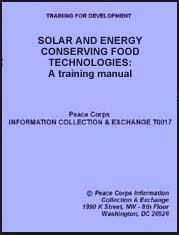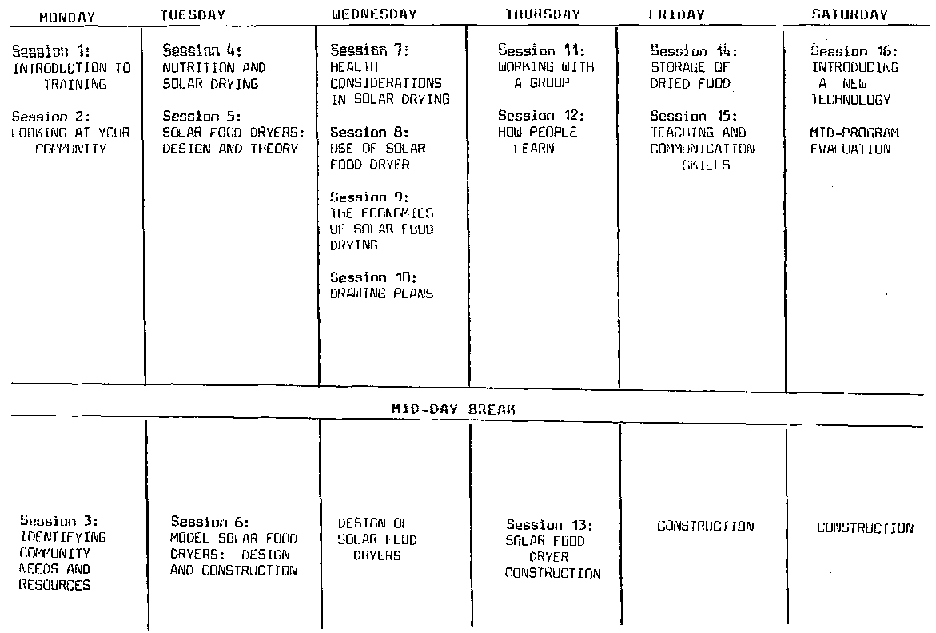
- (Peace Corps, 1984, 175 p.)
Fireless cookers[edit | edit source]
OVERVIEW AND GOALS:
Through the use of two well sealed and insulated containers (termed a Fireless Cooker), it is possible to cook for long periods of time using only retained heat. This session serves as an introduction to this easily built and low-cost fuel conserving device.
OBJECTIVES:
To analyze the advantages and disadvantages of a Fireless Cooker.
To learn to design, construct and use a Fireless Cooker.
RESOURCES:
Fireless Cookers
HANDOUTS:
"Fireless Cookers: Design and Use", Handout 17A
MATERIALS:
Large cooking pot with lid
Samples of low-cost, locally available insulation materials
Several examples of poor insulation materials.
Fireless cooker model
PREPARATION:
Using local materials, make at least one low-cost Fireless Cooker to use as a demonstration model.
Prepare a simulated cooking area (i.e., an open 3-rock fire or an overturned box with crumpled red cloth or paper on top) to be used in Step 1.
PROCEDURES AND ACTIVITIES:
- (15 minutes) Introduction: A Look at Traditional Cooking Fuels
Guide a discussion on traditional cooking fuels used in the participants' communities, as well as the problems associated with each (cost, scarcity, health problems, etc.).
Record the information on newsprint,
Ask if, based on this information, there seems to be a need for conserving cooking fuel in the participants' communities.
- (30 minutes) Decreasing Heat Loss
Using the cooking pot and simulated cooking area, discuss the many paths that heat from the fuel source actually takes.
During the discussion, elicit definitions of the three terms relating to heat transfer or lass: conduction, convection and radiation. Ask the group for ideas on how to significantly reduce the three types of heat loss occuring from the cooking pot, to allow more efficient use of the cooking fuel.
Guide them in concluding the following relationships:
Type of Heat Loss Prevented by:
Conduction Insulation
Convection Sealing openings well
Radiation Reflective lining
Display the Fireless Cooker model. Have the group analyze how effective it would be in significantly decreasing the three types of heat loss. Ask for suggestions to improve the design.
- (15 minutes) A Look at Insulation Materials
Display the examples of good and poor insulation materials.
Have the group decide in which category each material belongs, and why.
Guide them in determining what makes a material effective as an insulator.
Ask for examples of low-cost, locally available materials people think could be used in a Fireless Cooker. Record these on newsprint.
- (10 minutes) Definition and History of the Fireless Cooker
Elicit a definition of the Fireless Cooker from the group, to ensure that the idea of what it is and how it works is clear. Write the definition on newsprint.
Briefly review the history of Fireless Cookers, emphasizing the fact that it is an ancient method of conserving energy that is still widely used today.
- (20 minutes) Appropriateness of the Fireless Cooker
Facilitate a discussion to compare the advantages and disadvantages of Fireless Cookers. Record both in separate columns on a sheet of newsprint.
On the basis of this discussion, ask the participants whether they feel the Fireless Cooker is an appropriate technology for their own community. Why, or why not? What reactions do people anticipate from community members regarding the technology?
Ask for suggestions of some effective ways of introducing the new technology.
- (20 minutes) Design and Use of Fireless Cookers
Distribute and review Handout 17A, "Fireless Cookers: Design and Use". Ensure through ongoing questioning that everyone understands the reasons for the principles of Fireless Cooker design and use.
- (10 minutes) Summary
Answer any remaining questions about the information discussed.
Inform people that they will have the option of designing and constructing a Fireless Cooker as their second project.
TRAINER'S NOTE
The participants should submit a design and materials list for approval when their Solar Food Dryer is completed. Remind people that their Fireless Cooker should be easy to build so that there will be ample time to experiment with them during the course.
Fireless cookers
DESIGN AND CONSTRUCTION OF A FIRELESS COOKER:
- Gather your most commonly used cooking pots (with short handles only)
NOTE: The pots must have tight fitting lids and flat bottoms. A cooking pot made from any material will work well, although pots made from thick heat-retaining materials such as ceramic or iron will work the best.
- Measure the diameter of the pot (include handles in the measurement).
- Select a slightly larger, sturdy container.
- Line the container with foil or other sturdy reflective material (optional).
- Select an outer container (example: wooden keg, drawer, basket, cloth bag or a hole in dry ground) to go around the inner container. It should be large enough to allow a space of at least four inches between the walls and bottom of both containers where one is placed inside the other.
- Devise some way (using wooden blocks, "tin" cans, rocks, etc.) to support the inner container when a pot of food is placed inside it (Compressing the insulation will decrease its effectiveness).
- Select a low-cost insulation material (suggestions: crumpled newspaper, dry grass, wood shavings, feathers, wool, rags).
- Devise a way of surrounding the inner container with insulation.
- Moisture-proof the insulation by enclosing it in plastic. (Insulation loses its effectiveness when wet). This may be done with a series of "pillows"; one for the top, one for the bottom, and either one long or several smaller ones for the sides. Se sure the pillows are large enough so that no heat leaks will occur where two of the pillows meet.
10. Devise a top for the Fireless Cooker to cover the insulation material if desired (for aesthetic purposes). If you are using a wooden box for the outer container, insulation may be included in the lid instead of being in a separate pillow.
USING A FIRELESS COOKER:
- A Fireless Cooker may be used to cook any foods that are normally cooked in a liquid.
- Use slightly less water (approximately 9/10 the normal amount), as little is lost through evaporation.
- Bring the covered pot of food to a boil, then simmer for the following amounts of time:
SOUPS, STEWS, BEANS: 10-15 minutes
MEAT, FISH: 10-30 minutes
CEREAL AND GRAINS: 1-5 minutes
The exact time needed will depend on the size of pieces of food being cooked (e.g., chunks vs. shreds of meat). Use the above mentioned foods to approximate others not included in the list.
- Put the pot of food in the Fireless Cooker, and place the insulated cover over the top. The Fireless Cooker should be placed as close to the cooking area as possible to minimize heat loss when transferring the pot.
- Cooking time should be slightly increased to compensate for the steadily decreasing temperature inside the pot. Experiment in the beginning to understand how efficiently your Fireless Cooker will perform.
- Avoid opening the Fireless Cooker as much as possible during the cooking process to avoid unnecessary heat loss.
- A well built Fireless Cooker should maintain enough treat to cook food for at least eight hours. If yours is not performing well, check for heat leaks or areas with insufficient insulation.
- Fireless Cookers may also be used to incubate yoghurt or as a cool or cold storage box.
FIRELESS COOKER
